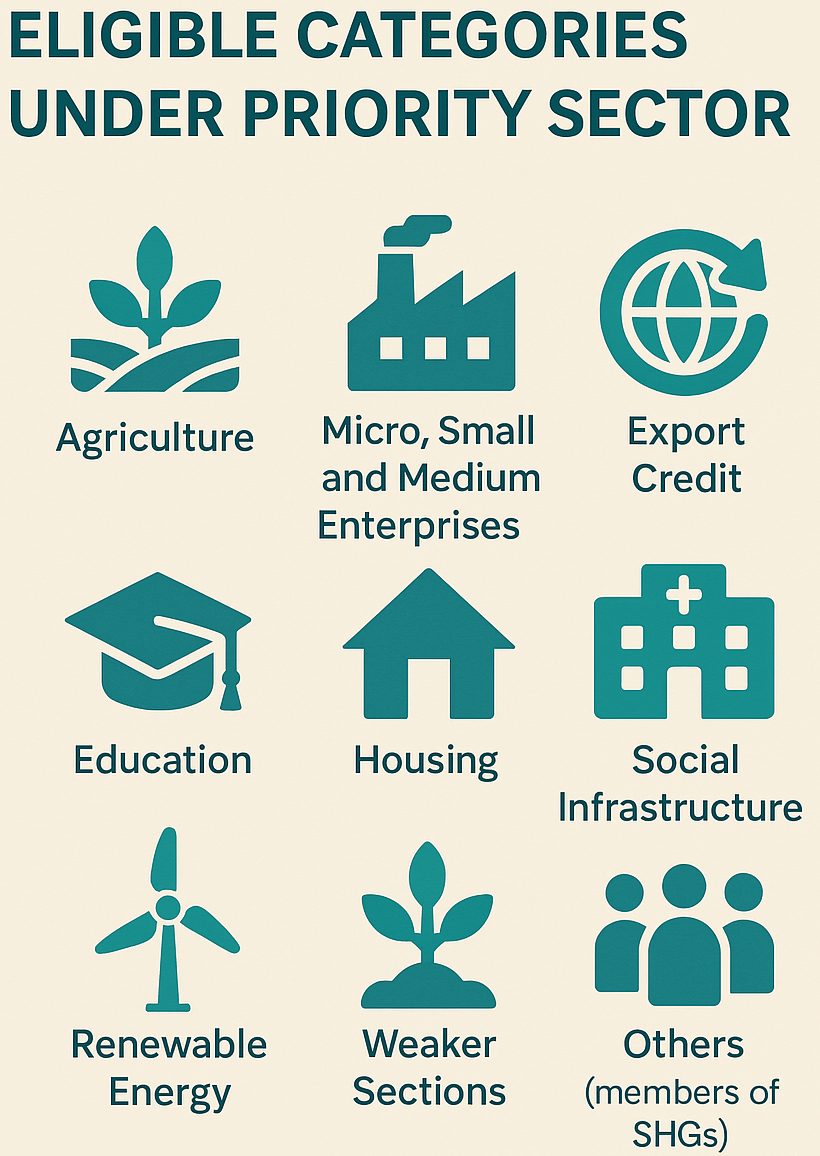Indian Economy
Revised Priority Sector Lending Guidelines
- 28 Mar 2025
- 7 min read
For Prelims: Reserve Bank of India, Priority Sector Lending, Priority Sector Lending Certificates, Rural Infrastructure Development Fund
For Mains: Priority Sector Lending Evolution, Impact & Challenges, Financial Inclusion through PSL
Why in News?
The Reserve Bank of India (RBI) has issued revised Priority Sector Lending (PSL) guidelines under the Banking Regulation Act, 1949. These updates aim to enhance credit flow to priority sectors and promote inclusive growth.
What are the Revised PSL Guidelines 2025?
- Higher Loan Limits for Education: The RBI has increased the loan limit under PSL for education from Rs 20 lakh to Rs 25 lakh per individual.
- Renewable Energy Loans: Loan limits for renewable energy projects like solar power, biomass, and micro-hydel plants raised from Rs 30 crore to Rs 35 crore per borrower.
- Loans for individual households for renewable energy remain capped at Rs 10 lakh per borrower.
- PSL Targets for Urban Cooperative Banks (UCBs): Revised PSL target for UCBs reduced to 60% (from 75%) of Adjusted Net Bank Credit (ANBC) or Credit Equivalent of Off-Balance Sheet Exposure (CEOBE), whichever is higher.
- Housing sector: Loans limits are increased to boost affordable housing, particularly in Tier-III to Tier-VI cities.
- Expansion of the ‘Weaker Sections’ Category: The list of eligible borrowers under the ‘Weaker Sections’ category has been expanded, it now includes transgenders, promoting financial inclusion and better credit access for underprivileged groups.
Note: ANBC is the total net bank credit after making necessary deductions and adjustments, and CEOBE is the amount representing the credit risk exposure of off-balance sheet items such as guarantees and letters of credit.
What is Priority Sector Lending?
- About: PSL is an RBI-mandated requirement for banks to allocate a set portion of their loans to key priority sectors that face credit shortages but are crucial for inclusive economic growth.
- Priority Sector Lending Certificates (PSLCs) are tradable certificates issued against priority sector loans.
- Evolution of PSL: Gadgil Committee (1969) proposed the 'Area Approach', leading to the Lead Bank Scheme (LBS) for regional credit planning.
- The Nariman Committee (1969) supported the Gadgil Committee's recommendations and recommended that each Public Sector Bank should adopt certain districts as 'Lead Banks' to boost PSL.
- PSL was formalized in 1972 based on the RBI’s Informal Study Group’s report (1971). Initially, no targets were set, but in 1974, banks were advised to raise PSL to 33.3% by 1979.
- Krishnaswamy Committee (1980) recommended a 40% PSL target by 1985, with sub-targets for agriculture and weaker sections.
- Usha Thorat Committee (2009) endorsed the continuation of the LBS for its role in the expansion of PSL.
- PSL Targets for Banks:
|
Bank Category |
Target |
|
Scheduled Commercial Banks (SCBs) & Foreign Banks (with 20+ branches in india) |
40% of ANBC or CEOBE, whichever is higher |
|
Foreign Banks (less than 20 branches) |
40% of ANBC or CEOBE (export Credit: Minimum 32%, and non-export sectors 8%) |
|
Regional Rural Banks (RRBs) & Small Finance Banks (SFBs) |
75% of ANBC or CEOBE, whichever is higher |
- Consequences for Banks Missing Targets: Banks failing to meet PSL targets must contribute to the Rural Infrastructure Development Fund (RIDF) and other designated funds at fixed interest rates, ensuring funds still reach priority sectors.
Note: Foreign banks ( with <20 branches in India) cannot buy PSLC General to meet their 8% target for non-export sectors but can purchase PSLCs for Agri, MSMEs, and Small and Marginal Farmers.
What are the Challenges Regarding PSL?
- Sectoral Imbalances: Banks often prefer lending to MSMEs or housing sectors within PSL as they are commercially more viable.
- Sectors like small and marginal farming remain underfunded, despite being a core PSL component.
- High Non-Performing Assets (NPAs): Banks face challenges in recovering PSL loans, especially in agriculture, leading to high NPAs and financial strain.
- Studies show PSL contributes to higher defaults due to borrower vulnerability and political interference (with initiatives like loan waivers) further discourage lending.
- Low Profitability for Banks: PSL loans usually have lower interest rates and higher default risks, which makes them less profitable for banks.
- Target-Driven Approach: PSL has become target-driven rather than outcome-oriented. Banks focus on meeting quotas, often through indirect or non-priority avenues, which dilutes the real developmental impact.
What Can Be Done to Enhance PSL?
- Performance-Based Incentives: Shift from quota-based lending to an impact-driven approach focused on poverty reduction, livelihood generation, and social outcomes.
- Introduce performance measurement through social impact audits and development indicators instead of just credit disbursal figures.
- Enhance Risk Mitigation : Establishing dedicated credit guarantee schemes for high-risk segments under PSL, such as the Credit Guarantee Fund Trust for Micro and Small Enterprises (CGTMSE), can significantly mitigate the risk of NPAs.
- Digital and Technological Integration: Leverage Big Data to profile borrowers, predict risks, and personalize credit products. Use geotagging to assess farm output, enhancing agri-credit reliability.
|
Drishti Mains Question: How does Priority Sector Lending (PSL) contribute to financial inclusion and economic growth? |
UPSC Civil Services Examination, Previous Year Question (PYQ)
Mains
Q. Pradhan Mantri Jan Dhan Yojana (PMJDY) is necessary for bringing unbanked to the institutional finance fold. Do you agree with this for the financial inclusion of the poorer section of the Indian society? Give arguments to justify your opinion. (2016)





